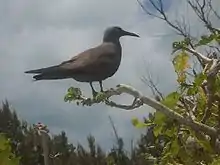Lesser noddy
The lesser noddy (Anous tenuirostris), also known as the sooty noddy, is a seabird in the family Laridae. It is found near the coastlines of Comoros, Kenya, India, Maldives, Mauritius, Seychelles, Sri Lanka and United Arab Emirates.
| Lesser noddy | |
|---|---|
 | |
| Scientific classification | |
| Kingdom: | Animalia |
| Phylum: | Chordata |
| Class: | Aves |
| Order: | Charadriiformes |
| Family: | Laridae |
| Genus: | Anous |
| Species: | A. tenuirostris |
| Binomial name | |
| Anous tenuirostris (Temminck, 1823) | |
The lesser noddy was at one time considered as a subspecies of the black noddy (Anous minutus).[2] The close relationship between the two species was confirmed by a molecular phylogenetic study published in 2016.[3]
Taxonomy
The first formal description of the lesser noddy was by the Dutch zoologist Coenraad Jacob Temminck in 1823 under the binomial name Sterna tenuirostris.[4][5] The genus Anous was introduced by the English naturalist James Francis Stephens in 1826.[6] Anous is Ancient Greek for "stupid" or "foolish". The specific name tenuirostris is from the Latin tenuis for "slender" and -rostris "-billed".[7]
There are two subspecies:[8]
- A. t. tenuirostris (Temminck, 1823) - islands of the west & north Indian Ocean
- A. t. melanops Gould, 1846 - Houtman Abrolhos Islands (Western Australia)
Description
The lesser noddy is 30–34 cm (12–13 in) in length with a wingspan of 58–63 cm (23–25 in) and a weight of 97–120 g (3.4–4.2 oz). The plumage is brownish black. The forehead and crown are lighter in colour. This species is smaller and slightly paler than the similar black noddy and has pale rather than dark lores.[2]
References
| Wikimedia Commons has media related to Anous tenuirostris. |
| Wikispecies has information related to Anous tenuirostris. |
- BirdLife International (2012). "Anous tenuirostris". IUCN Red List of Threatened Species. 2012. Retrieved 26 November 2013.CS1 maint: ref=harv (link)
- Gochfeld, M.; Burger, J.; Garcia, E.F.J. "Lesser Noddy (Anous tenuirostris)". In del Hoyo, J.; Elliott, A.; Sargatal, J.; Christie, D.A.; de Juana, E. (eds.). Handbook of the Birds of the World Alive. Lynx Edicions. Retrieved 17 April 2017.
- Cibois, A.; Thibault, J.-C.; Rocamora, G.; Pasquet, E. (2016). "Molecular phylogeny and systematics of Blue and Grey Noddies (Procelsterna)". Ibis. 158: 433–438. doi:10.1111/ibi.12363.
- Temminck, Coenraad Jacob (1838) [1823]. Nouveau recueil de planches coloriées d'oiseaux, pour servier de suite et de complement aux planches enluminées de Buffon. Volume 5. Paris: F.G. Levrault. Plate 202.
- Peters, James Lee, ed. (1934). Check-list of Birds of the World. Volume 2. Cambridge, Massachusetts: Harvard University Press. p. 347.
- Stephens, James Francis (1826). General zoology, or Systematic natural history, by George Shaw. Volume 13, Part 1. London: G. Kearsley. p. 139. The title page gives the year as 1825.
- Jobling, James A. (2010). The Helm Dictionary of Scientific Bird Names. London: Christopher Helm. pp. 48, 381. ISBN 978-1-4081-2501-4.
- Gill, Frank; Donsker, David, eds. (2019). "Noddies, gulls, terns, auks". World Bird List Version 9.2. International Ornithologists' Union. Retrieved 24 June 2019.
